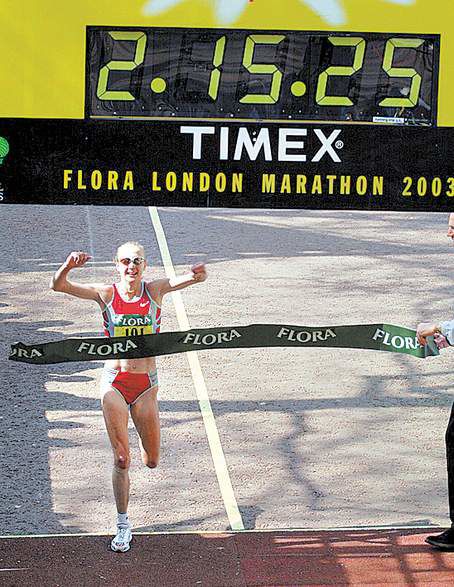Women need men to set records? Yes and no
Published 5:00 am Saturday, September 24, 2011

- Paula Radcliffe crosses the finish line to win the women's London marathon in 2003 with a world-record time of 2 hours, 15 minutes and 25 seconds. Because she ran with men in the event, it will no longer be considered the world record.
World’s highest mountain? Easy. World’s fastest man? Easy, too. The world record for female marathon running? That, too, used to be a cinch until the bright sparks who oversee track and field delivered a slap against women everywhere by invalidating their records set when they run marathons alongside men.
The not-so-subtle message is that women cannot complete 26.2 miles as quickly alone as they can when they have a helping hand from the guys.
That, as it happens, may be true. Still, that doesn’t make this rule change from the International Association of Athletics Federations any less offensive, impractical or confusing. It’s also a giant black eye for Paula Radcliffe.
Her world record of 2 hours, 15 minutes, 25 seconds set in London in 2003 is one of the all-time great sport performances by anyone, anywhere. No woman, except for Radcliffe herself, has ever run within three minutes of that mark.
Yet, from Jan. 1, 2012, it will no longer count as the world record — for the simple reason that Radcliffe ran that April day with male pacemakers. Instead, from January, the world record will be the fastest marathon run by a woman when she competes only against other women.
It just so happens that that mark is Radcliffe’s, too: 2:17:42, also set in London, in 2005.
But that Radcliffe is only being half-robbed doesn’t make this decision easier to swallow.
Many in running agree that women run marathons faster when paced by men. “Probably a two-minute advantage,” says Mary Wittenberg, race director of the New York City Marathon.
Keeping pace with a fast man can provide a target to aim for. Running in a group can be less tiring for the mind and help shield a runner from wind.
Radcliffe was in great shape in 2003. The London conditions were perfect, not too hot or cold and with light winds. The race director, Dave Bedford, did sprinkle a few male pacemakers into the women’s field that year — because he wanted to show that doing so could produce quicker times.
But how much did they really help Radcliffe?
“It is fair to say that had she been on her own that day she may not have run as fast,” Bedford says. “Because she wouldn’t have had women on that same level to compete against.”
But Wittenberg says that “Paula ran that race on her own legs and probably would have run pretty darn close” to 2:15:25 even without the men.
“The pacers were far to the sides,” Wittenberg says. “She wasn’t surrounded by all those guys.”
So would Radcliffe have been minutes slower, just seconds, or equally quick? No one will ever be sure. But to now take away her world record and downgrade it to a mere “world best” gives the impression that Radcliffe owes a lump of her astounding performance to men, that they somehow helped drag her over the line. That surely wasn’t the IAAF’s intention. Still, it is grossly unfair.
“That time, in itself, deserves the title of world record, because that is what it was given at the time,” says Bedford. “That has been taken away, and that is wrong.”
World records are records because they are absolute. Everest is the tallest peak. Usain Bolt is the fastest man. Simple.
But women’s marathon will now have two IAAF marks — the “world record” set in women-only races, and “world best” set in mixed fields.
Imagine the confused kid when a woman next runs under Radcliffe’s revised world record of 2:17:42 but slower than her world best of 2:15:25.
“Daddy, was that a new world record?”
“Yes … but only because we happen to be in London. It wouldn’t have been in Berlin or Chicago. Oh, also, it’s the world record but it’s not the fastest marathon by a woman ever.”
Mmmm. Good luck with that.
Limiting world records to female-only fields also seems bizarre for the simple reason that most marathons run men and women together. So the 1.2 million spectators who line Berlin’s streets for its marathon — being run this Sunday — or the 1.5 million who turn out for Chicago’s won’t ever see a woman set a world record (although they might see a “world best”) because both have mixed fields.
“You are effectively saying that the vast majority of road races worldwide are now ineligible, ever, to have the world record, unless they have a women-only race,” says Bedford. London — like New York and Boston — showcases the women by having them set off before the men in their own race.
One solution that Wittenberg and Bedford both favor would be to have two sets of world records — one for times run with men and the other without. That would recognize that these are races under different conditions and could perhaps be easier to understand — just as everyone understands that timed ascents of Everest are different when done with or without oxygen. Both ways have their merits, neither is easy. In both cases, the fastest deserve full recognition for their feat. That means a record — not a “best-but-not-a-record,” or a “record-but-not-the-best.”
“There are two playing fields,” says Bedford. “Let’s have two records, dead simple.”
Adds Wittenberg: “The fair thing and the right thing to do by athletes is recognize both performances and don’t go backward.”
Or, my preference, simply let Radcliffe’s existing world record stand.
Let a record be a record be a record. Be clear. With men or without men, everyone can understand that it’s the woman who runs it that really counts.
The fastest-ever is 2:15:25.
Beat that.






